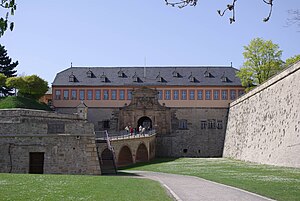
Back Zitadelle Petersberg German Ciudadela de Petersberg Spanish Cittadella di Petersberg Italian Petersbergcitadel Dutch Cidadela de Petersberg Portuguese Citadela Petersberg Slovenian
| Petersberg Citadel | |
|---|---|
| Erfurt, Germany | |
 | |
| Coordinates | 50°58′43.25″N 11°1′6″E / 50.9786806°N 11.01833°E |
| Type | Citadel |
| Area | 36 hectares |
| Site history | |
| Built | 1665–1868 |
| Built by | |
| In use | 1665–1963 |
| Materials | Stone and brick |
Petersberg Citadel (German: Zitadelle Petersberg) in Erfurt, central Germany, is one of the largest and best-preserved town fortresses in Europe.[1] The citadel was built on Petersberg hill, in the north-western part of the old town centre from 1665, when Erfurt was governed by the Electorate of Mainz.[2] It is surrounded by over two kilometres of stone walls and is 36 hectares in size.[3]
Erfurt has also been ruled by Sweden, Prussia, Napoleon, the German Empire, the Nazis, and post-World War II Soviet occupying forces, and it was part of the German Democratic Republic (East Germany). All of these regimes used Petersberg Citadel and had an influence on its development. The baroque fortress was in military use until 1963.[4] Since German reunification in 1990, the citadel has undergone significant restoration and it is now open to the public as a historic site. Its maze of underground passageways are also open to visitors and the fortress bakery (1832) is again in working order.[5]
The fortress is also known by its French name, Citadelle Petersberg, as French troops were stationed there from 1806 to 1814, when Erfurt was under Napoleonic occupation. Napoleon visited Erfurt several times and the citadel was further developed during his rule, although parts of it were damaged in a battle in 1813.[6]
The citadel was built on the site of a medieval Benedictine Monastery and the earliest parts of the complex date from the 12th century.[7]
The former lower barracks (German:Untere Kaserne) building is now used to house and administer archives of the Stasi Records Agency.[5]
The Cyriaksburg Citadel, is a smaller fortress to the south-west of Erfurt city centre, which dates from 1480. It is now the home of the German Horticulture Museum.[8] During the Napoleonic period a hidden trench connecting the two citadels was built. The remains of this connection can still be seen at the Cyriaksburg Citadel today.[5]
- ^ Stadtverwaltung Erfurt (17 November 2017). Petersberg. Retrieved 23 December 2017
- ^ Kogel, Kristina (2011). Erfurt an einem Tag. Ein Stadtrundgang. Leipzig: Lehmstadt Verlag
- ^ Erfurt Tourismus & Marketing Petersberg Citadel (pdf) Archived 2018-01-03 at the Wayback Machine. Retrieved 2 January 2013
- ^ Steffen Raßloff (2012). Geschichte der Stadt Erfurt. Erfurt: Sutton Verlag.
- ^ a b c Verein der Freunde der Citadelle Petersberg zu Erfurt e.V. (2015). 350 Jahre Zitadelle Petersberg. Tagungsband: Wissenschaftliches Kolloquim zum 350. Jahrestages der Grundsteinlegung der Zitadelle Petersberg vom 29. Mai bis 31 Mai 2015. Universität Erfurt.
- ^ 1806–1814: Erfurt unter französischer Besetzung. Erfurt Stadtverwaltung. Retrieved 23 December 2017
- ^ Friedrich, Verena (2003). Die ehemalige Benediktinerklosterkirche St. Peter and Paul, Erfurt. Regensburg: Verlag Schnell & Steiner
- ^ Die Cyriaksburg: Sitz des Deutschen Gartenbaumuseums Erfurt. Retrieved 23 December 2017
© MMXXIII Rich X Search. We shall prevail. All rights reserved. Rich X Search

